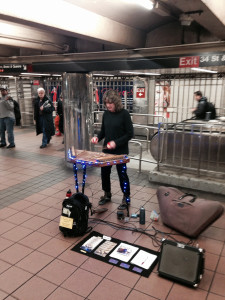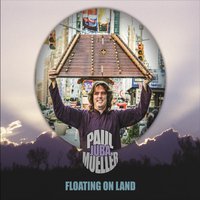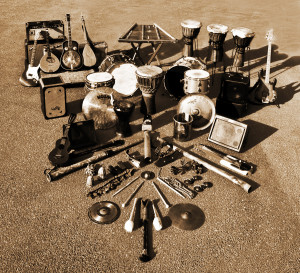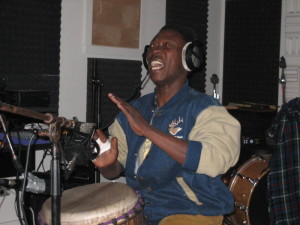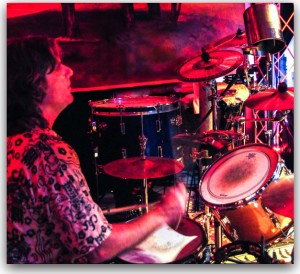Subway to Studio: Paul Juba Mueller and the Art of Recording Unusual Instruments
Want to know the power of music? If you’re lucky enough to come across Paul Juba Mueller and his hammered dulcimer in the New York City subway system, you’ll experience it first-hand.
The people of New York City – we-with-no-time-for-anything-ever – stop and listen. They feel something deep, beautiful, dark, entrancing, energizing, and serene, emanating from a historic instrument that’s perfectly in synch with our 21st Century city.
Mueller has transformed countless passersby into audiences as part of the famed Music Under New York program, which allows MTA-sanctioned artists to perform in the NYC subway. It’s a sprawling transit system that can put him in contact with any one of the 5,597,551 people who ride a train every weekday.
Whether playing solo or as part of the adventurous rhythm ensemble Mecca Bodega, Mueller performs with a Zen focus, totally in the zone while still engaged with his surroundings. His hammered dulcimer – a trapezoidal percussion and stringed instrument — has a nice attack, then quickly evolves into a fuller, pleasing sound that seems to cushion the claustrophobic air of the train tunnels.
And that’s just live. Albums featuring his work, such as Mecca Bodega’s Hammered Dulcimer, Rhythm Rail, and Raise the Tent, are all gorgeous records, essential tools for energetic meditation. Got a tough mental project to tackle? Need your hands and muscle to get an extensive outdoor job done? These albums will help you focus right in, with the rare ability to be played again and again, end-to-end.
Mueller takes all this to the next level with his new self-released record, Floating on Land. Each song offers its own particular transcendence, merging Mueller’s masterful skills on the instrument with guest musicians like Dr. Djo Bi Irie Simon, who brings expert djembe and conga partnership to the tracks. Cello, harp, banjo, tiple, mountain dulcimer, native Lakota flute, and bass are also on hand.
In addition, Mueller recorded drum kit and an arsenal of world percussion for the record. All of it was tracked at his upstate NY facility, Sound Tree Studio. In this interview with SonicScoop, Mueller shows the studio side of being a subway performer, sharing techniques and tips for capturing unusual acoustic instruments – especially percussion – in a recording session.
How would you describe your own particular musical approach?
I like making original music that features drums and percussion in the forefront of the music, and I’m open to try any sounds or instruments to accompany the rhythms and melodies that are created.
I’ve played drum kit supporting singer/songwriters before in situations where the drum’s role in the song is sometimes an afterthought, and I’m more interested to enjoy making new music that is more exciting for me to play and have listeners move their bodies, be transported and feel good because of the presence of drums and percussion.
Over the years I’ve tried to be a part of musical situations where rhythm is understood to be important, and while creating my new CD Floating On Land I found out that my experiences and improved musical abilities allowed me to try things I couldn’t have before, and create rhythms and melodies with better musicians because I now have something more to offer.
I have more confidence in my understanding of using polyrhythms while writing melodies which gives me freedom to try writing in different keys and overlapping time signatures that I never tried to write in before. Now it’s easier for me to realize quickly when an idea or instrument is working, or when I should let it go because it isn’t working and try something else.
How would you say that the experience of playing in the subway has evolved for you over the years – what’s the best part about it, and makes it stressful?
The playing experience in the subway changes over the years as the economy changes, security and political things change, and the technology commuters carry around with them change.
In general, as years pass there are more and more distractions people have while they commute like iPhones, video games and other devices with ear buds that cut people off from their immediate physical surroundings and block spontaneous experiences people can share in person. A lot of the overload of technical information people are exposed to pulls them out of truly being in the moment, and being completely present.
This makes it more challenging while playing subway music to get people to stop and listen, because so many people are cut off from their environments and their attention spans and ability to focus on one thing or have a spontaneous experience has been lost.
I now play the hammered dulcimer standing up, have added lights to my merchandise display, added downloadable music purchase options, and keep trying to make eye contact and smile with people to make a connection with them as I play. All these things help spread my music to people, and have them buy CDs etc…when the window of time to get through to people keeps shortening.

The expansive NYC subway system provides its share of opportunities and challenges. (photo: David Weiss)
What are the unique ways that the many instruments and musicians on “Floating On Land” play off of each other and work together, to provide both harmony and contrast?
The hand drums and drum kit drive the rhythm with help from a low-tuned bass drum played with a soft mallet while standing, and then there are shakers and metal percussion parts that are played on upbeats or on top to lock in the rhythms.
I percussively play melodic hammered dulcimer and West African balafon which is the bridge between the other stringed instruments and the drums/percussion. The Colombian tiple Chris Merwin plays is a little like a mandolin, and sounds like it was specifically made to be played with the dulcimer even though the tiple and dulcimer were invented during different time periods and in different parts of the world. The tiple and dulcimer play off each other naturally, and weave through the rhythms exchanging leads as the dulcimer locks into the drums and does call-and-answer responses with the hand drums.
Some of the metal percussion and low end drums are a great contrast in texture to the generally sweeter sounds of the hammered dulcimer, mountain dulcimer, harp and cello. The polyrhythms are often syncopated and the long sustain of the dulcimer, cello and nature field recordings glide on top or provide atmospheric open space for the songs.
Paul, you personally have developed a deep relationship with the hammered dulcimer. Why do you continue to gravitate to it? What are the unique properties of this instrument in your opinion?
I love playing the hammered dulcimer because I can express myself melodically at the same time I am drumming on it rhythmically. It’s like playing the inside of a piano with sticks, and it seems more natural for me to make music through my hands rather than using just my fingers like I would be doing playing the keys of a piano.
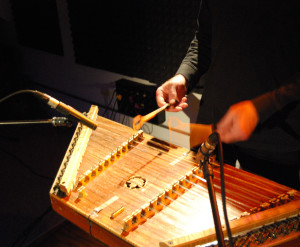
Mueller’s hammered dulcimer, miked at Sound Tree Studio with a stereo pair of Neumann KM 184’s (photo: Ian Sheridan.
The dulcimer is versatile and can be played intimately and softly, but it also has the rhythmic strength to play off a drum kit, hand drums or any powerfully deep groove. I love the mesmerizing quality of the dulcimer, and when drums hit you in the gut and make you move your body, the dulcimer can help send your mind into a trance — so when drums and dulcimer are played together, you can have a full mind, body, spirit release.
The way the notes on the dulcimer are physically positioned on the instrument are different than the way the notes on a piano or balafon are repetitively positioned. Each octave on the dulcimer isn’t laid out the same, so as I move around the instrument when writing songs, the melodies come out very different than if I had written them on the piano, and that makes them sound a little more unique.
Staying on the hammered dulcimer tip, where there new avenues of expression that you wanted to explore with the hammered dulcimer in Floating On Land?
On Floating On Land, I used several different hammers that have different materials like wood, leather, and felt on the part that hits the strings, so I was able to vary the sounds of the instrument and also experiment with using studio effects as well.
The dulcimer I play now has a damper pedal, so on this CD, I could at times play fast, rhythmic, supporting parts and use plucking sounds and not be concerned that my parts would sound muddy or overpower a lead instrument. Then I could shift gears and not use the damper pedal and take a lead and use the beautiful-sounding sustain that the dulcimer has. I feel like these things made my dulcimer melodies and rhythms stronger on “Floating On Land” and opened up some space and dynamics in the music.
I also wrote in keys, including a Pentatonic scale, I’ve never written in before with the dulcimer because of the different accompanying instruments like the harp that sounds great in keys not often played on the dulcimer, because of how the notes are laid out physically on the dulcimer.
Do you think your years of playing in the subway informed your writing for Floating on Land?
Years of playing in the subway keeps me growing and improving on my instruments, because I’m regularly playing in front of people and can try things and take chances musically that I might not try on a gig in a club or on a conventional stage.
A few of the beginning melodies and rhythms used on Floating On Land came out of improvising while playing street music, and I think being reminded of people’s attention spans while playing street music helps when I arrange and edit song ideas when I write in the studio.
What is the crossover that you see between the hammered dulcimer and hand drumming — how are you bridging those two worlds in “Floating On Land?”
The hammered dulcimer and hand drums are acoustic instruments often made with similar materials, so they naturally sound great together. The dulcimer was originally called a santur and was made in Persia before there was electricity and was made to accompany the playing of hand drums at the time.
Since I approach the hammered dulcimer as a drummer, I play it percussively so it works really well with the hand drums. When I mixed the CD, I just needed to be sensitive to where I placed the instruments in the stereo field and how I equalized them so their sounds complemented each other and melded together.
What is the full complement of hand drums that were used on “Floating On Land”? What makes a drum/percussion instrument a good complement to the hammered dulcimer?
The hand drums that were played on “Floating On Land” are djembe, dumbek, congas, udu and frame drum. A drum/percussion instrument is a good complement to the hammered dulcimer because the dulcimer is a percussion instrument that’s also melodic. It’s made of wood and is organic like a lot of hand drums that are made of wood and animal skins.
When hand drums are played, the skin-on-skin sound has an intimate quality that sounds great with the intimate quality that the dulcimer has the potential to achieve. A good musician playing the dulcimer or the hand drums is inspired by rhythm.
What’s an example of how the hammered dulcimer and hand drums came together on one of the songs on Floating On Land?
During the first song, “Bhote Kosi” there is a shuffle feel played by the hammered dulcimer and balafon with a danceable groove provided by the kick drum, brushes on a snare, shakers and bass guitar.
The original idea for the feel of the song came from improvising outside one late night on the porch of Charley Buckland’s upstate cabin with me playing hammered dulcimer and Charley playing mountain dulcimer. The mountain dulcimer weaves flowing melodies played off of the hammered dulcimer and then after a break, the djembe adds adrenaline and ties everything together by rhythmically going back and forth between responding to the mountain dulcimer solo and the groove established by the bass, kick and snare. There are a lot of polyrhythms going on with the stringed instruments and balafon and Ivory Coast master drummer Dr. Djo Bi is able to add energy, excitement, and cohesiveness to the song with his djembe.
There are a lot of different types of wood and strings vibrating together on Bhote Kosi which gives it a deep, rich sound and the flowing feel of motion that reminds me of the river in Nepal that the song is named after.
The song “The Caravansarei” came together in a way that I had never experienced before when writing music. Chris came to my studio with a tiple song he was working on in 6/8 and in the same key as a song I was working on alone with the dulcimer but in 4/4. When I heard his parts, I played my parts and they fit almost perfectly together with a cool 6 over 4 thing happening. Towards the end of the song, I wanted there to be a climax, so when the dulcimer opens up with a fast, rhythmic lead, udu, frame drum and bass guitar are introduced for the first time in the song to punctuate the sound and give the dulcimer a percolating rhythm to ride on top of.
While mixing the song, I was able to equalize and pan the udu, frame drum and bass, and mold them into one unique sound that I think is engaging and supports the Middle Eastern feel of the tune.
Tell us about Sound Tree Studio, in Granite Springs, NY, where Floating On Land was recorded.
I built the studio from 2000-2003 in between continuing to work as a full-time musician and recording engineer. I had no official opening date, because before I was finished building the studio I was already mixing tracks that were recorded in other studios and recording several other solo artists’ CDs that I could accomplish even though my studio wasn’t completely built.
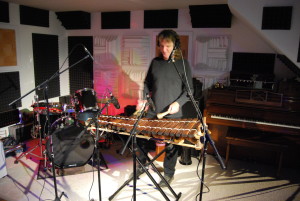
Recording West African balafon at Sound Tree, with Sennheiser 421’s for close mics, and Neumann KM 185’s for far mics.
I was also lucky through some friends to hook up with an audio company who had me help multi-track record large shows that included high profile artists like The Allman Brothers, and I was hired to do mixes for DVD releases. The timing was right, as I was able to keep income flowing to help pay for the studio building costs.
It’s ideal to record my music in the studio because the percussion and drums sound great in the space, and also it’s located in a natural, wooded area with tall, old trees. Since I play a lot of organic instruments, it seems like a natural fit and the relaxed atmosphere makes it easy for musicians to focus and not be stressed when they record here.
When I record here myself, I don’t have to break everything down in the middle of a session and I can just start off the next day where I left off and not lose the flow. Financially, it’s a tremendous help not having to pay for studio time. It keeps the overhead low when making a CD, and keeps the focus on making music instead of watching the clock. I also can try out an idea anytime of the day or night without having to get hung up with scheduling studio time.
I have a Soundcraft Ghost board and like using analog equipment like the HHB Classic 60 tube compressor, in addition to using the more usual digital equipment.
What are some techniques you’ve developed/improved on for recording an acoustic instrument like the hammered dulcimer? Are there parallels between recording the hammered dulcimer and some other more traditionally American instruments?
I think when it’s possible, acoustic instruments like the hammered dulcimer, mountain dulcimer, tiple, banjo and Native Lakota flute should be recorded stereo because the richness of sound can be captured that way and when mixing, the engineer has the option to have the instrument’s sound cover the entire or partial stereo field or be mixed as a single point sound.
This makes mixing ideas very flexible depending on the type of song that it is and how many instruments are accompanying the acoustic instrument. There are parallels between recording the hammered dulcimer and other traditional American instruments, like piano and drums, because they are all percussive, so you have to be aware of the dynamic ranges of how much air is moving from the instruments and also that there are a lot of frequencies and overtones that are produced by the instrument.
Mic placement is extremely important and being careful to get as much signal without distortion or breakup is essential. It’s always better to get a clean, full frequency recording rather than having to add low end or other frequencies in a mix, because that tends to muddy things up.
Do you have some recommendations/tips for how to approach recording a non-traditional instrument – what have you learned about capturing the sound of an instrument that you’ve never recorded before?
When recording a nontraditional instrument or instrument you’ve never recorded before, it’s really important to understand where the sound is emanating from the instrument — walk around the room and listen to how the instrument sounds from different distances, and how the sound projects into the room.
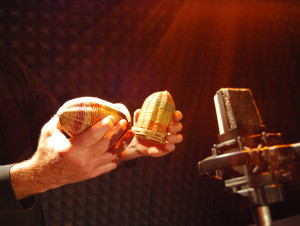
“It’s really important to understand where the sound is emanating from.” Caixixi Shakers recorded with AKG 414.
Stereo mic these instruments when at all possible and tight mic as well as mic from a distance, so when the instrument is mixed in context with other instruments you have all you need to make it sound great.
What are some do’s and don’ts that you’ve learned about recording percussion?
When recording percussion, try to capture the impact of the air moving so you’ll feel the punchiness and root sounds of the instrument. Capture the subtleties of the playing but get the attack as well. For instance, when I record djembe, I mic the bottom of the drum for the low-end impact but I also tight mic the top and mic from a distance as well.
It’s important to not block a performance by placing mics in the musician’s way. The musician should be able to play the instrument freely without feeling confined by poor mic placement. Record all the tones and frequencies of an instrument, but not at the expense of a great performance.
While recording Floating On Land, I tried to just use mics and mic pre-amps and not use any signal processing, even compressors, in the signal path. I like to use good mic placement and do all my processing, EQ’ing, etc. while mixing, so if I’m adjusting sounds during a mix when things are in context, I am not having to undo things that I did during the actual recording.
Last question! What made it essential for you to record “Floating On Land” yourself — what are the challenges and rewards of being your own studio and engineer for your music?
There are a lot of reasons why I wanted to record “Floating On Land” myself. One reason is that I understand the importance of good drum sounds, and I also don’t treat drums and percussion as simply support instruments only. A lot of engineers I’ve worked with have never recorded some of the instruments I play, or treat drums and percussion almost like an afterthought. They don’t get the concept that drums can be in the forefront of music or actually be the music.
During Floating On Land I spent a lot of time and care shaping the sounds while mixing. There are multiple percussion parts played covering a wide range of frequencies, and it was challenging to make all of the parts clearly heard and felt. I could achieve a good sound without having to communicate to another engineer what I was going for because I could do it myself and try everything that I wanted to.
It’s rewarding in a way when I’m able to achieve the result I’m striving for, and if I don’t get there, I have no one else to blame and sometimes I end up in a better, unexpected place with the mix. It’s challenging being my own sound engineer, though, because before guest musicians arrive to record, I have a lot of preparation and planning to do and have kicked out a lot of energy before recording actually begins. I then have to bounce between being an engineer and musician when listening back to the recorded tracks and it can be challenging to keep focused and make clear decisions on what are good takes and what audio-wise sounds good.
Sometimes later, when I’m mixing and producing, I have to cut parts, make them sound right with other instruments, or create depth in a mix by having a part played be far back in the mix. When a musician only played one part in a song, sometimes they expect that part to be highlighted, even though it’s a support instrument. When mixing, I need to make tons of decisions that are all about trying to improve the strength or feeling of a song, and I need to choose the tracks that offer the strongest support for the whole of the song regardless of individual parts.
If you are a musician who is engineering your own project, one thing that I think is valuable to do, if time allows, is to give some time — maybe even a month — between the recording sessions and mixing the CD.
It’s good to step away from being so close to the emotional side of a recording and get a clearer idea of where you think the song could go during a mix. The down time helps clear the head and ears and helps you be more objective, open and precise when trying ideas while mixing.
— David Weiss
Please note: When you buy products through links on this page, we may earn an affiliate commission.







